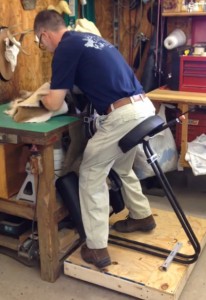Designers: Garrett Kelly, Kimanthi Gicovi, Abdel Abada
Client Coordinator: Dr. Deborah Thorpe
Supervising Professor: Larry Bohs
INTRODUCTION
Our client, a taxidermist with cerebral palsy, spends many hours standing upright at a defleshing machine, which causes him discomfort and soreness. The goal of this project is to design and construct a device that will allow the client to maintain a comfortable and biomechanically aligned position while performing taxidermic procedures. The device consists of a frame with chest, knee, and rear pads which maintain and support the prone standing position. The device utilizes an open frame design for accessibility and is mounted to a platform for stability. Using the device, the client will be more comfortable and experience less stress on his joints, thus increasing his productivity and minimizing possibility for long term injury.
SUMMARY OF IMPACT
The Ergonomically Supportive Fleshing Chair distributes weight and promotes a correct posture to reduce the amount of stress on the client’s shoulders, back, and lower limbs during the fleshing process. The client notes increased comfort while using the fleshing machine in the chair. His therapist states that the chair “meets the needs of the client and solves some pretty tough issues related to height, his lack of range of motion in legs and knees and his muscle stiffness.”
TECHNICAL DESCRIPTION
The Custom Standing Aid Device (Figure 1) comprises a platform, frame, three pipe connectors, two base connectors, two support connectors, a pommel connector, chest support, knee support, seat support, and abduction pommel.
The platform is 28”x36” and is constructed from 2x4s and plywood. Four 4×4 legs extend the height to 5”. A 3/8” thick vinyl anti-fatigue mat is connected with aluminum corners. Anti-skid pads are attached to the feet of the platform.
The frame is wrought from two 3/4” O.D. black steel pipes (i.e. gas line) with 1/8” thickness, using a pipe bender. The final shape of the frame has a height of 60” and a length of 38”. The frame is angled at 40 degrees from the horizontal where the seat pad connects, at 70 degrees from the horizontal where the leg and pommel pads connect, and at 50 degrees from the horizontal where the chest pad connects.
The pipe connectors and base connectors is cut and machined from solid aluminum blocks to clamp the pipes of the frame in place. The pipe connectors are 1-1/4”x1-1/4”x4” with holes spaced 2-3/4” apart for the frame pipes and are clamped together with 3/8” bolts. The 1-1/4”x1-1/4”x12” base connectors also contain frame pipe holes and bolt clamps and are bolted through the platform at the ends of the connectors with 5/16” bolts.
The support connectors are 1-1/2”x6-3/4”x1/8” aluminum plates bent around the frame. Four 1/2″ sheet metal screws connect the plates to the support pads.
The pommel connector contains a 4-7/8”x3”x7/16” aluminum plate clamp connected to two 4”x3-1/4”x1” aluminum wedges, which are connected to a 4”x16”x1/8” steel plate. The frame is clamped between the wedges and the plate clamp and the steel plate is held at a 70 angle from horizontal.
The chest, knee, and seat supports and abduction pommel are made of high resilient foam and a plywood backing, and are upholstered with faux leather.
The client is shown using the fleshing machine with the Custom Standing Aid Device in Figure 2. The total cost of materials of the device is approximately $210.

